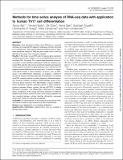Methods for time series analysis of RNA-seq data with application to human Th17 cell differentiation
Author(s)
Aiho, Tarmo; Chen, Zhi; Salo, Verna; Tripathi, Subhash; Lahesmaa, Riitta; Lahdesmaki, Harri; Butty, Vincent L G; Burge, Christopher B; ... Show more Show less
DownloadBurge_Methods for time.pdf (1.487Mb)
PUBLISHER_CC
Publisher with Creative Commons License
Creative Commons Attribution
Terms of use
Metadata
Show full item recordAbstract
Motivation: Gene expression profiling using RNA-seq is a powerful technique for screening RNA species’ landscapes and their dynamics in an unbiased way. While several advanced methods exist for differential expression analysis of RNA-seq data, proper tools to anal.yze RNA-seq time-course have not been proposed.
Results: In this study, we use RNA-seq to measure gene expression during the early human T helper 17 (Th17) cell differentiation and T-cell activation (Th0). To quantify Th17-specific gene expression dynamics, we present a novel statistical methodology, DyNB, for analyzing time-course RNA-seq data. We use non-parametric Gaussian processes to model temporal correlation in gene expression and combine that with negative binomial likelihood for the count data. To account for experiment-specific biases in gene expression dynamics, such as differences in cell differentiation efficiencies, we propose a method to rescale the dynamics between replicated measurements. We develop an MCMC sampling method to make inference of differential expression dynamics between conditions. DyNB identifies several known and novel genes involved in Th17 differentiation. Analysis of differentiation efficiencies revealed consistent patterns in gene expression dynamics between different cultures. We use qRT-PCR to validate differential expression and differentiation efficiencies for selected genes. Comparison of the results with those obtained via traditional timepoint-wise analysis shows that time-course analysis together with time rescaling between cultures identifies differentially expressed genes which would not otherwise be detected.
Availability: An implementation of the proposed computational methods will be available at http://research.ics.aalto.fi/csb/software/
Date issued
2014-06Department
Massachusetts Institute of Technology. Department of BiologyJournal
Bioinformatics
Publisher
Oxford University Press
Citation
Aijo, T., V. Butty, Z. Chen, V. Salo, S. Tripathi, C. B. Burge, R. Lahesmaa, and H. Lahdesmaki. “Methods for Time Series Analysis of RNA-Seq Data with Application to Human Th17 Cell Differentiation.” Bioinformatics 30, no. 12 (June 15, 2014): i113–i120.
Version: Final published version
ISSN
1367-4803
1460-2059